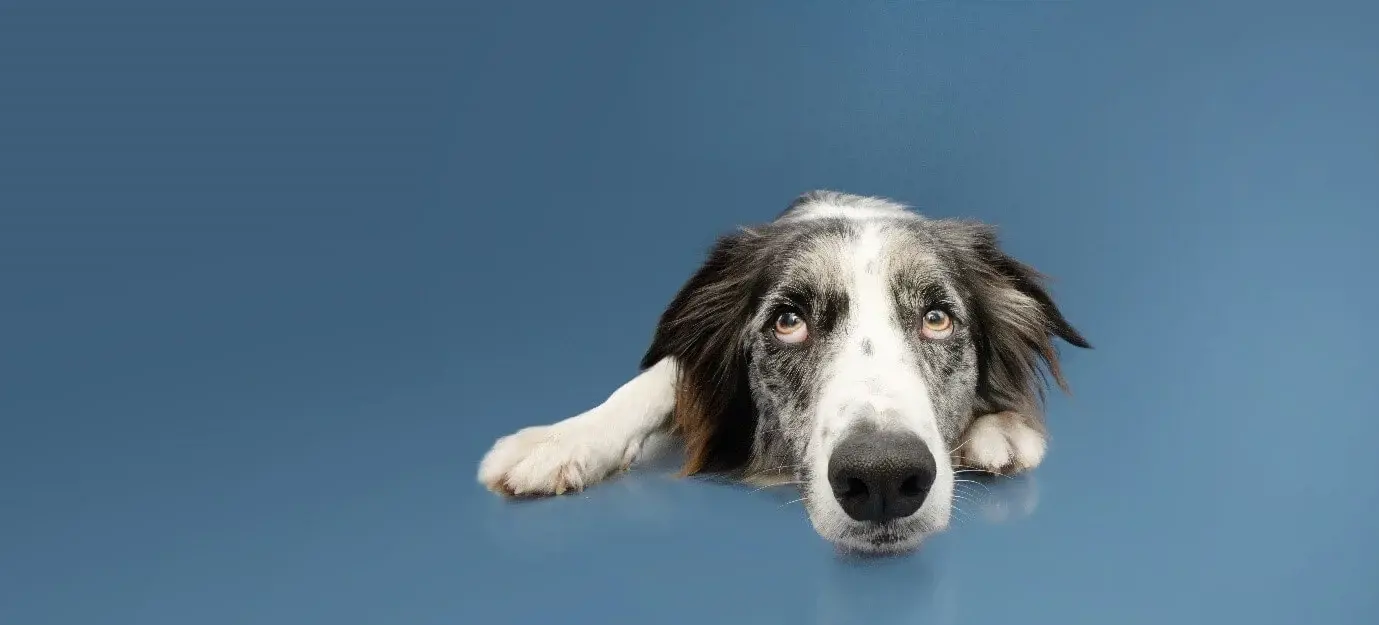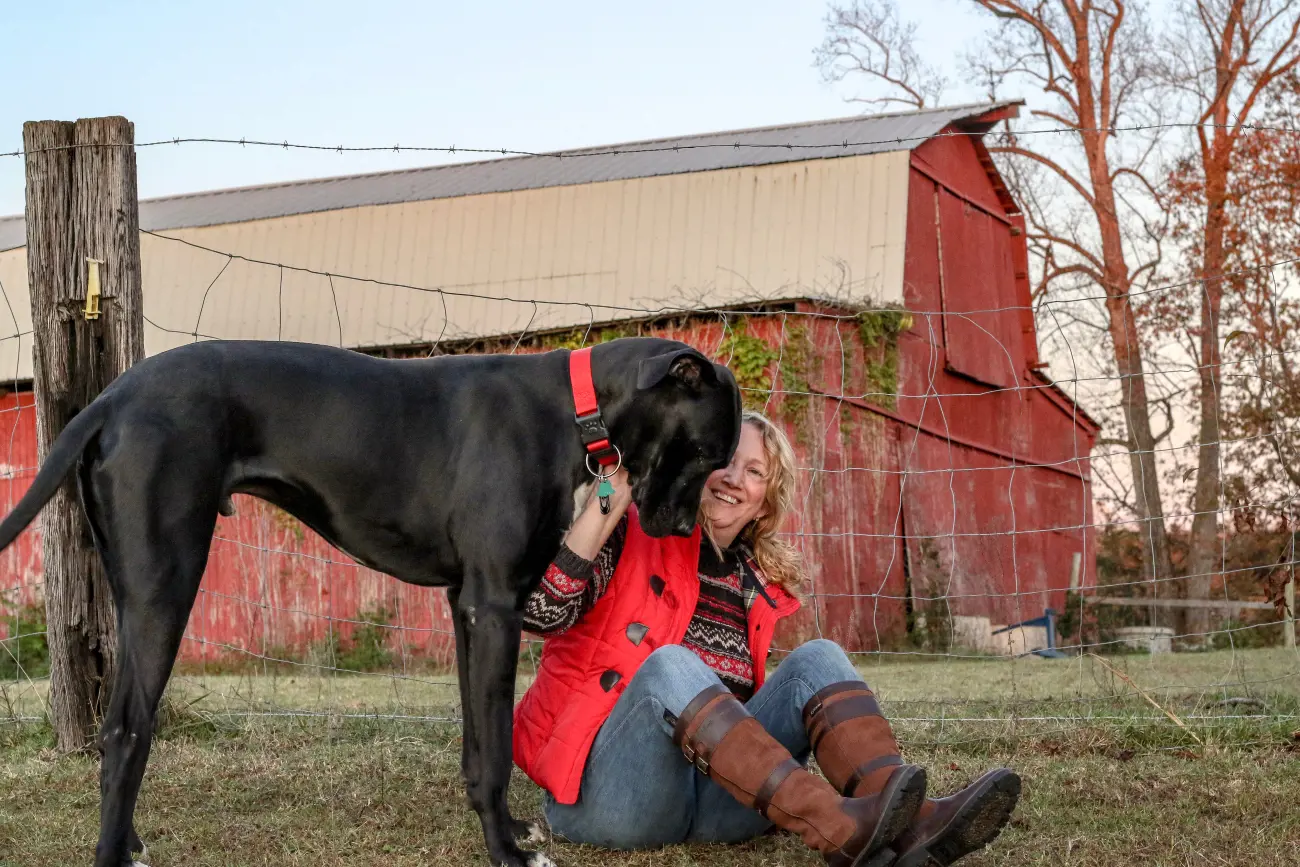How to calm dog anxiety
22nd April, 2024

Changes in routine can be a stressful situation for everyone, including our pets, which can result in anxiety and overall discomfort.
There are a number of things that can trigger stress or anxiety in your pet, including holiday events, unfamiliar people, new pets in your household, loud noises, and even travelling in the car.
Or maybe your pet is just naturally anxious, this can be common as it can be with humans.
Regardless of the situation, there are signs you can see which may tell you your pet is anxious, and there are ways that you can help.
How do you help a dog with anxiety?
There are numerous ways you can help soothe your dog if they are feeling stressed or anxious without the need for medical intervention.
What will work will vary between individuals, so don’t be discouraged if your first attempts at calming them don’t have the desired effect.
Some common ways to help treat your dog’s anxiety include:
- Remove triggers - If you know what causes your pet’s anxiety, removing these triggers where possible will help ease their worries or stress.
- Distracting your pet - if you can’t remove the trigger try to distract your pet with toys or having the music on, anything to keep them occupied and not paying attention to the trigger.
- Medication - For some dogs, there are pet medications designed to calm and de-stress your pet, these can come in diffusers, sprays tablets and more.
What are signs of anxiety in dogs?
It can be distressing to see your pet in distress, but there are ways you can help put them at ease, and the first step is recognising the signs that they’re uncomfortable, this will vary depending on what type of pet you have, but some common signs of anxiety in pets can include:
- Drooling or panting.
- Changes in behaviour (such as hiding or being less interested in toys or affection).
- Changes in appetite (eating or drinking more or less than usual).
- Excessive vocalising (such as whimpering, crying, etc.).
- Pacing or restlessness.
- Urinating or defecating in the house or outside their designated area.
If you notice any of these signs in your pet, then it could be a sign of anxiety, and the first step to making them feel more comfortable is to find the root cause so you can begin to find ways to help.
How can I calm my anxious dog down?
If you know what triggers your dog’s anxiety, the first thing you should do is take away the trigger. If you can’t, try to distract your furry friend with Dog Toys, or boredom breakers such as KONG.
Other ways you can calm your anxious dog are through exercise, physical contact and comforting them.
If your dog is suffering from separation anxiety an effective way to help ease their worries is to give your dog a special treat or boredom breaker when you leave to keep them occupied.
Or to leave them with something with your scent to comfort them while you’re gone.
Also, to get them used to you being gone try to go for short periods of time and then increase the length of time slowly.
Another way you can treat dog anxiety is through a range of medications.
From Dog Calmers such as calming sprays, liquids, toys, and collars. Or you can try Dog Anxiety Medication such as tablets, pheromone diffusers and more.
These will help to calm your dog and can be given before the trigger, or if your dog is naturally anxious, they can be given to calm them regularly.

How can I de-stress my dog?
Let’s face it, whether you have two legs or four, stress is a part of life. Recognising whether your dog is stressed is the first step.
There’s lots you can do to help make your pet feel less stressed and more at ease once you know what to look for.
Understanding the cause of your dog’s stress will also help you choose the best way to help your dog calm down.
Give your dog time away: Avoiding or removing your dog from a stressful situation will help, whether that’s outside or in your home. You could create a separate space away from excited children with a safety gate, create a homely bed or crate for them to relax where they won’t get disturbed.
- Exercise your dog: Most dogs love their walks! Not only are they good for their physical health but walks will help your dog’s mental well-being too, having lots of things to sniff, look at and enjoy.
- Stay nice and calm: Many dogs are extremely sensitive to their owners’ emotions. If your dog is stressed, keep calm, and try not to panic or raise your voice, as this may add to your pet’s stress levels.
- Keep your dog entertained: There are lots of things you can do inside your home to keep your dog entertained. This can help keep their mind focused and distracted from things they find stressful.
- Don’t tell them off: Don’t punish your dog, especially if they are showing defensive behaviours as this is likely to make them even more stressed. Telling them off may mean they stop one behaviour, such as growling, but start biting or snapping instead.
- When to see an animal behaviourist: If your dog is showing aggression or displaying any other problematic behaviours, talk to your vet and find a professional animal behaviourist to help. They will be able to help identify what’s causing the stress and give you advice on how to manage it.
Exercise And Playtime Are Important

Just as physical activity can work wonders for human anxiety, it can also significantly alleviate anxiety symptoms in dogs.
Achieving this requires a combination of daily walks, playtime, necessary mental stimulation, and engaging sports.
These activities not only keep them healthy but considerably boosts their self-esteem which, in turn, aids in reducing anxiety.
Dogs are naturally active creatures. They enjoy running around, exploring their environment, and engaging in play.
Regular exercise provides them with necessary mental stimulation, keeping them happy and content.
In fact, physical activity can reduce anxiety symptoms in dogs, promoting a happier, healthier life for your pet.
When dogs engage in physical activity, they're not just burning off energy.
They're communicating with the world, learning about their environment, and most importantly, building self-esteem.
A relaxed, self-assured dog is less likely to experience anxiety or demonstrate anxious behaviours.
Create a Safe, Calm Place for Your Dog
Sometimes we all need a break, and so does your pup!
Your dog might be naturally shy or nervous around different kinds of people, be fearful of loud noises or events, or deal with separation anxiety when left alone.
Even if you’ve got a chilled-out pooch, creating a safe place for your furry friend can help expedite house and obedience training and provides a comfortable place for him or her to go when they want to relax!
Giving your dog the choice and autonomy to leave a situation increases their confidence in dealing with uncertain or stressful situations.
Creating a safe place for your dog is essential to their overall well-being and training.
It provides them with a comfortable and secure space where they can relax and feel at ease.
By incorporating the elements of comfort, food and water, easy access, stress reduction, stimulation, and safety, you can ensure that your dog's safe place is a positive and inviting environment for them.
Give Your Dog Plenty to Do When They're Alone
Dogs are social creatures who want to be around their humans, and for some, being alone causes separation anxiety.
Teaching your dog how to be alone can go a long way to preventing anxiety. It’s also important to give your dog lots of things to do while they’re on their own.
Give them a favourite chew bone or a food-stuffed chew toy to keep them occupied or consider using puzzle toys that exercise your dog’s mind.
Finally, some dogs like the background noise of a TV or radio so they don’t feel as alone.
Why Are Dogs Anxious?
Dog anxiety can have a variety of causes. Some of the most common causes of dog anxiety are:
- Fear
- Separation
- Ageing
Fear-related anxiety can be caused by loud noises, strange people or animals, visual stimuli like hats or umbrellas, new or strange environments, specific situations — like the vet’s office or car rides — or surfaces like grass or wood floors.
Although some dogs may only have brief reactions to these kinds of stimuli, they may affect anxious dogs more consequentially.
Separation anxiety is estimated to affect around 14 percent of dogs.
Dogs with separation anxiety are unable to find comfort when they are left alone or separated from their family members.
This anxiety often manifests itself in undesirable behaviour’s, such as urinating and defecating in the house, destroying furniture and furnishings, and barking.
Age-related anxiety affects older dogs and can be associated with cognitive dysfunction syndrome (CDS). In dogs with CDS, memory, learning, perception, and awareness start to decline, similar to the early stages of Alzheimer’s disease in humans.
This understandably leads to confusion and anxiety in senior dogs.
Symptoms of anxiety in dogs
Pacing or shaking- You have seen your dog shake after a bath or a roll in the grass.
That whole body shake can be amusing and is quite normal…unless it is occurring as the result of a stressful situation. For example, dogs are commonly stressed when visiting the veterinarian.
Many dogs “shake it off” when they descend from the exam table and touch down on the ground. Dogs, like people, also pace when agitated.
Some dogs walk a repeated path around the exam room while waiting for the veterinarian to come in.
Whining or barking- Vocalization is normal self-expression in dogs but may be intensified when they are under stress.
Dogs that are afraid or tense may whine or bark to get your attention, or to self soothe.
Yawning, drooling, and licking- Dogs yawn when they are tired or bored, they also yawn when stressed.
A stressful yawn is more prolonged and intense than a sleepy yawn. Dogs may also drool and lick excessively when nervous.
Changes in eyes and ears- Stressed dogs, like stressed people, may have dilated pupils and blink rapidly.
They may open their eyes really wide and show more sclera (white) than usual, giving them a startled appearance.
Ears that are usually relaxed or alert are pinned back against the head.
Changes in body posture- Dogs normally bear even weight on all four legs. If a healthy dog with no orthopaedic problems shifts his weight to his rear legs or cowers, he may be exhibiting stress.
When scared, dogs may also tuck their tails or become quite rigid.
Shedding- Show dogs that become nervous in the show ring often “blow their coat.”
Dogs also shed a lot when in the veterinary clinic. Although less noticeable in outside settings, such as visiting a new dog park, shedding increases when a dog is anxious.
Panting- Dogs pant when hot, excited, or stressed. If your dog is panting even though they have not exercised, they may be experiencing stress.
Changes in bodily functions Like people, nervous dogs can feel a sudden urge to go to the bathroom.
When your dog urinates shortly after meeting a new canine friend, he may be marking territory and reacting to the strain simultaneously. Refusal of food and loss of bowel function are also stress indicators.
Avoidance or displacement behaviour- When faced with an unwelcome situation, dogs may “escape” by focusing on something else.
They may sniff the ground, lick their genitals, or simply turn away. Ignoring someone may not be polite, but it is surely better than being aggressive.
If your dog avoids interaction with other dogs or people, do not force the issue. Respect their choice.
Hiding or escape behaviour- An extension of avoidance, some tense dogs literally move behind their owners to hide. They may even nudge their owners to prompt them to move along.
As a means of escape, they may engage in diversion activities such as digging or circling or may slink behind a tree or parked car.
How can I prepare and help my dog become less afraid next time?
Depending on what your dog is afraid of, there are a few things you can do to help them:
- Always make new things a positive experience. Make sure your dog sees new things and experiences as really positive. Praise them and keep your tone happy if they react to new things in a way you like. As your dog becomes more confident, new things probably won’t scare them as much.
- Avoid or reduce the things that scare them. If it’s possible to avoid or reduce the cause of their fear this will often help to stop their nervousness getting worse. If your dog is afraid of noises, you can leave a radio or TV on as a distraction and to drown out the sounds. With storms and fireworks, your dog may get scared of the lights as well as the noise, so close the curtains or blinds in the room your dog is in. You can even build them a den to hide in to help them feel safe as this will often help your dog feel less frightened whatever the cause of their fear. If you see something that you know they’re scared of when you’re out on a walk, try to go the other way before your dog notices and starts to become nervous.
- Introduce new things slowly. Sometimes new things can surprise your dog if they aren’t used to them, so try to introduce any new sights, sounds and experiences to them as slowly as possible.
- Praise calm behaviour. Praise your dog calmly to help keep them relaxed if they are managing to stay settled despite a scary noise or sight. If your dog is worried at first, let them hide if they need to and give them lots of praise once they’re calm.
- Always stay calm. The more worried you get, the more worried your dog is likely to get. If they are showing signs of stress and being afraid, stay as calm as possible as this will help them feel more at ease.
- Get a sound CD. You can buy special CDs that have common sounds on them which can be played to help your dog become used to noises that worry them. Start with the volume very low and praise and reward your dog for calm behaviour. Over the course of several months, you can gradually increase the volume by small amounts each time you play the CD, again praising calm behaviour. If your dog becomes stressed it’s best to start again with the sound very low and focus on building confidence at each step of increased volume. Use lots of positive interaction such as playing with your dog and giving them their food or treats while the CD is playing so they associate the scary noises with good things.
- Try a pheromone plug-in or collar. These products can help your dog feel calm.
- Contact your vet and an accredited behaviourist. If your dog is struggling with anxiety, it’s important to get them professional help as soon as possible. Fears tend to get worse over time and if you wait too long your dog’s behaviour will often become increasingly extreme. It’s especially important to get your dog checked if they have suddenly started showing signs of fear or if they are starting to be afraid of lots of different things.
Helpful Pages
Recent Posts

Why do Great Danes bury their heads?
12/03/25
Find out more about Beagles
28/02/25Pet Insurance Quote
- 98% claims paid *
- Claims paid directly to vets
- 24/7 vet video consultations
- Interest free monthly payments


